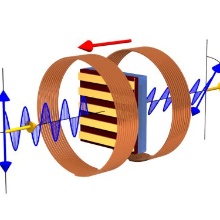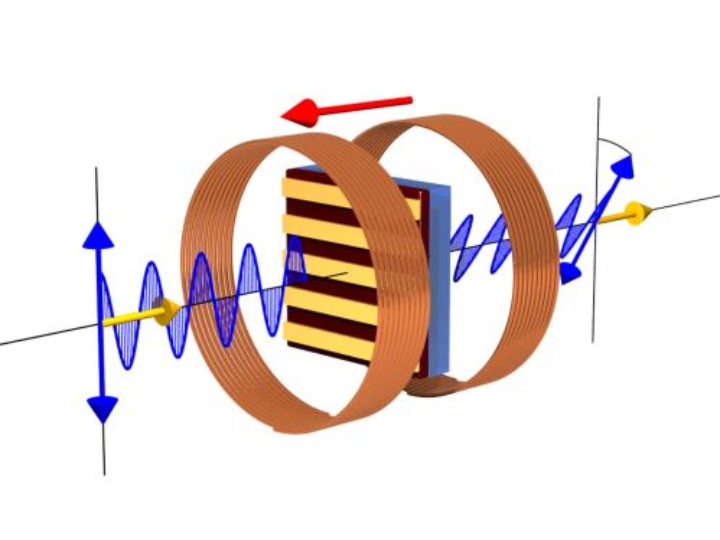Plasmonics is about tailoring the optical light-matter interaction at the nano-scale. It brings along new concepts of nano-materials and optical devices in medical imaging, energy harvesting, and bio- and chemical sensing. Now researchers have introduced nonreciprocity into a plasmonic system to enhance the Faraday Effect in a thin film. The collaborative team from University of Stuttgart (Germany), University of Augsburg (Germany), and Lomonossov Moscow State University (Russia) reported their experiment on the plasmonically enhanced thin film Faraday effect a the paper in the journal Nature Communications.*)
The Faraday Effect was the discovered by the English physicist Michael Faraday in his pioneering experiment which demonstrated for the first time the interrelation between light and magnetism. In modern optical systems, it is the most important magneto-optical effect because of its crucial application in optical isolation. Optical isolators based on the Faraday effect are used in all kinds of optical systems to eliminate the back reflection in order to protect the sensitive laser sources.
The Faraday Effect describes the phenomenon where light traveling through a magnetized material
experiences a rotation of its polarization plane. But other than optical activity, which occurs for
example in a sugar solution and can also rotate the polarization direction of light, the Faraday
Effect is not reversible. This means that light propagating backwards is rotated further, whereas
in a sugar solution, the rotation is reversed.
The Faraday effect in nature occurs in materials such as quartz, but can be somewhat larger
in various rare earth garnet crystals. Still, in such materials the Faraday rotation per unit
length is typically small and, as a result, Faraday rotators and isolators are quite bulky. Driven
by the research goal to develop compact and integrated optical systems, “to enhance Faraday
rotation is of general interest and technological importance,“ says Jessie Y. Chin, postdoctoral
researcher and Carl Zeiss Fellow at the 4th Physics Institute and Research Center SCoPE at
University of Stuttgart.
Chin and her co-workers devised a sophisticated design, combining gold nanostructures with a
thin film of magneto-optical material. A localized particle plasmon resonance as well as a photonic
waveguide resonance can be excited in the hybrid plasmonic system. By engineering the geometry of
the plasmonic structure, the dispersions of these resonances can be tailored, which can alter and
enhance the Faraday effect in the thin film up to one order of magnitude. Combining the electron
beam lithography and the pulsed laser deposition techniques, they realized the design in
experiment. With the help of numerical simulations, the researchers provided a profound
understanding of the physical mechanism to their experimental results.
“We started with a fairly simple plasmonic structure in order to understand the underlying physics. Following our concept of the plasmonic Faraday rotator, there are a lot more ideas to try,“ says Chin. In the recent years, plasmonics has also been used to enhance many other magneto-optical effects. “Magnetism has always been relevant in real-life applications. Nonreciprocal plasmonics could lead to a plethora of future thin film devices,“ says Harald Giessen, Professor at the 4th Physics Institute and Research Center Scope at University of Stuttgart.
J. Y. Chin, T. Steinle, T. Wehlus, D. Dregely, T. Weiss, V. I. Belotelov, B. Stritzker, and H. Giessen, “Nonreciprocal plasmonics enables giant enhancement of thin film Faraday rotation”,Nature Communications 4, 1599 (2013). http://www.nature.com/ncomms/journal/v4/n3/full/ncomms2609.html
Contact Dr. Jessie Chin: University of Stuttgart, 4th Physics Institute,
j.chin@physik.uni-stuttgart.de, Phone ++49 711 68564962



